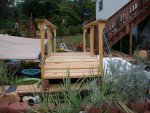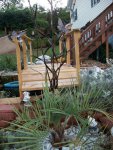Sorry I am late reading all the posts...............been busy being a 2nd time granny :razz:
Someone on another forum wrote this about the palms although I might add we have gotten down to -6 F here and the Chinese Windmill palms that grow around here have all survived nicely :
Trachycarpus wagnerius(dwarf Chusan Palm) is cold tolerant when older, but will need
protection to keep it above 10F just to stay alive and above 15F to keep
it looking healthy.
Trachycarpus Fortunei (windmill palm), is a
bit more cold tolerant. It will need to stay above 15F in its first
years, but when established, it can handle down to 10F or 5F with
minimal damage and probably survive 0F). One of mine was sick, but
despite that survived in my area with no protection, 3 record snow falls
(over a foot of snow each time which is a lot over here) and 14F. It
got no damage.
Needle palms are pretty cold tolerant, more cold
tolerant than windmill palms, and can handle probably around 0 to -5F
realisticly when an adult. It could handle lower for very very brief
periods and definitely not every winter, but still very cold tolerant.
Some people claim that it can handle -20F but that isnt realistic
because it cant see those type of temps without protection unless it is
very old, in a good spot, and for a very very brief period of time.
Yucca
rostrata should be okay but given protection below -10F. It might get
damage, but Im not sure because the ones by me have never gotten cold
damage and are in many peoples landscapes (and I dont live in a desert
either).
Trachycarpus fortunei - Chinese Windmill Palm
Trachycarpus fortunei
Very Cold Hardy/ Drought Tolerant
Common Names: Windmill Palm, Chinese Windmill Palm
Origin: China
Hardiness Zones: USDA: 8-10B; Sunset: 4-24, to 5[sup]o[/sup]F
Mature Height: 35’ with a 5’ spread
Trunk: single, slender, fibrous, leaf bases retained except near ground on older trees; no crownshaft
Canopy: 20-30 leaves, palmate, 2-3’ wide, deeply divided into segments that droop near tips, dark green, light silvery on underside
Flower Stalk: 18” highly branched
Growth Rate: slow
Drought Tolerance: high
Light requirement: moderate to full sun
Soil Requirement: adaptable
The Windmill Palm serves wonderfully as a small-scale accent tree all
along the Pacific Coast, and while it is often used in that capacity,
it also works well in larger massed and linear street or entrance
plantings. Take a look at the entrance to the Hollywood Bowl, for
example or in older plantings in Beverly Hills. Its bright, fan-like
fronds and attractive fringed trunk require little maintenance and stand
out among other plantings. One of the hardiest palms available, the
Windmill Palm adapts well to cooler, coastal zones from San Diego to
Seattle. We also see it planted at higher elevations and in Great Basin
climates like those in Nevada and even Utah. Reuben Ellis, one of the
owners of Ellis Farms, has grown Windmill Palms at 4200 feet in the
central highlands of Arizona. While most people associate the Windmill
Palm with its remarkable hardiness and slender profile, we also love the
characteristics of its trunk. Left to its natural habit, the trunk
exhibits a dense dark covering of fibrous “hair” produced from the bases
of its leaves as they age. We have also peeled the trunk for a truly
novel look—producing a smooth, pale skin with initially purple accents
that ages gracefully to gray






